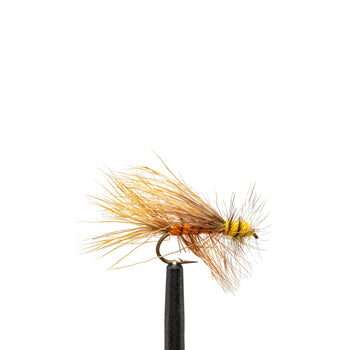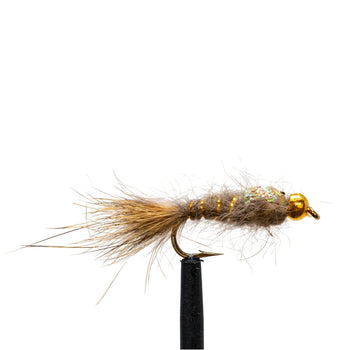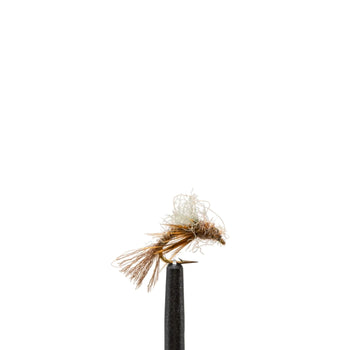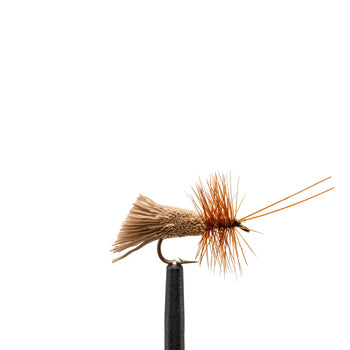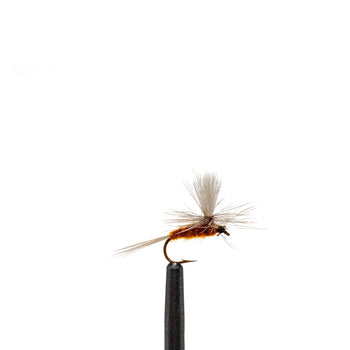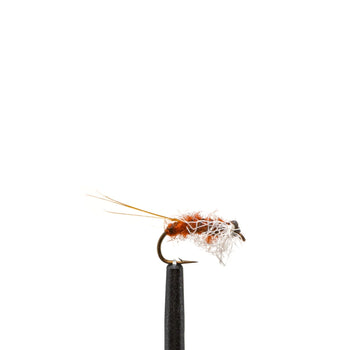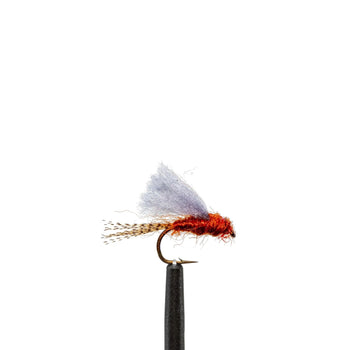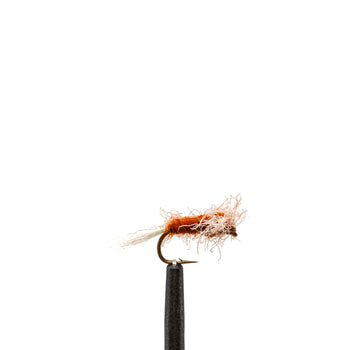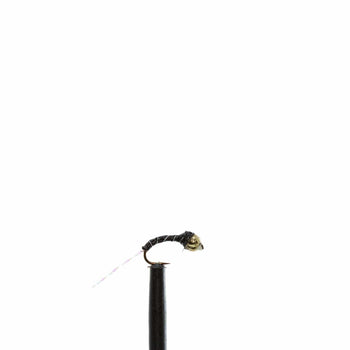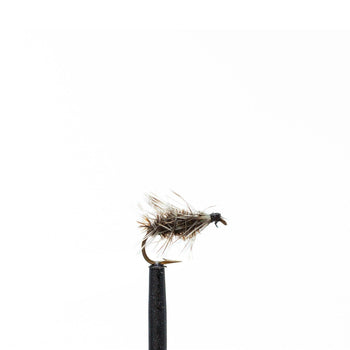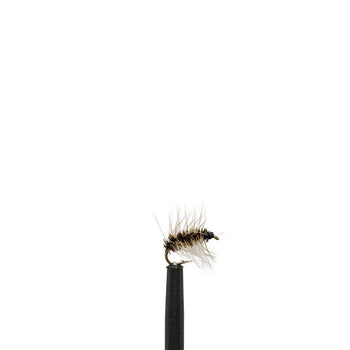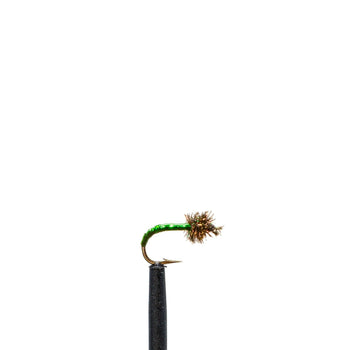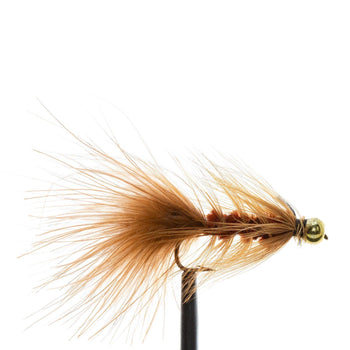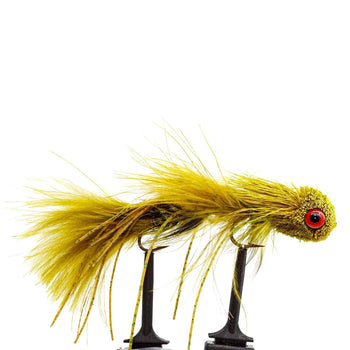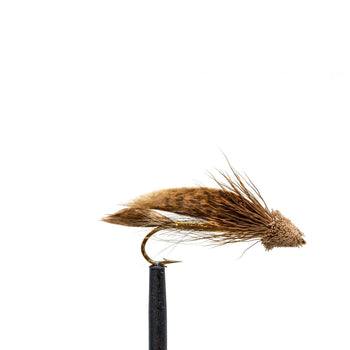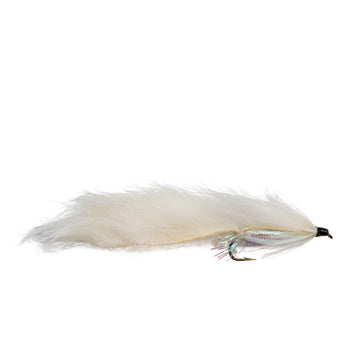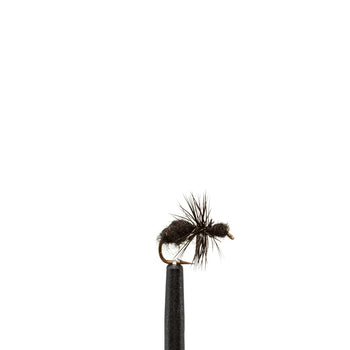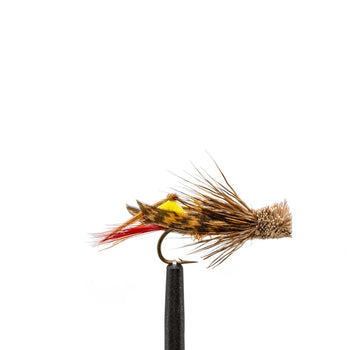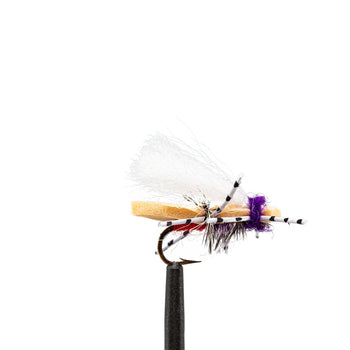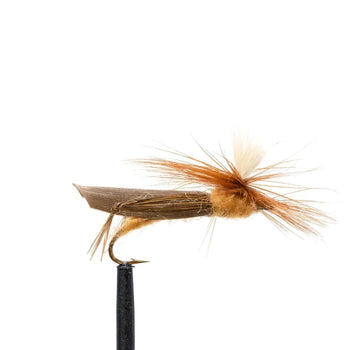Fall Fly Fishing Guide: Key Hatches & Essential Flies

As the vibrant colors of summer fade into the crispness of fall, fly fishing enters one of its most exciting and rewarding seasons. Cooler temperatures, lower water levels, and shifting insect activity make autumn an ideal time to be on the water. Trout become more active, feeding aggressively to bulk up before winter, and some species, like brown trout, prepare for their annual spawn. For fly anglers, this means an opportunity to catch some of the largest and most responsive fish of the year.
However, the key to fall fly fishing success lies in adapting to the changing environment. Insect hatches are different from the summer months, and trout behavior is influenced by cooler water and shorter days. Whether you're targeting big browns gearing up for their fall spawn or capitalizing on the last major hatches of the year, understanding fall hatches and matching your flies to these conditions is critical.
In this guide, we’ll break down the top fall hatches you’re likely to encounter, offer expert recommendations on the best flies to use, and share tips to maximize your success during this dynamic season.
Understanding Fall Hatches
Fall represents a transition period for both fish and insects. As days grow shorter and temperatures drop, some aquatic insects go into a final feeding frenzy before hibernation or laying eggs. Trout, in turn, become more aggressive, bulking up for winter and responding to the abundant food supply. Unlike summer, where fast, light presentations dominate, fall fly fishing often rewards a slower, more deliberate approach with careful attention to depth and drift.
Hatch Calendar
Here’s a quick seasonal reference to keep your fall fishing focused:
- Late Sept–Nov: Blue-Wing Olives; daily on overcast afternoons.
- Mid Sept–Late Oct: October Caddis; dusk/evening skitters and splashy eats.
- Late Sept–Oct: Mahogany Duns; best on cloudy afternoons in softer water.
- Oct–Winter: Midges; become primary food in colder temps and tailwaters.
Water Temp Guide
Knowing the temperature ranges that trigger insect activity can help you pick the right fly at the right time:
- BWOs: ~45–55°F
- Mahoganies: ~48–56°F
- October Caddis: most active late day in ~48–54°F
- Midges: reliably active ~38–48°F
Top Fall Hatches and Best Flies to Use
From tiny mayflies to hulking caddis, these are the hatches that define fall and the flies that consistently fool trout.
1. Blue-Wing Olive (Baetis)
Blue-Winged Olives (BWOs), or Baetis mayflies, are a staple hatch in fall, often occurring in cooler, overcast conditions from September through November. These small insects (#16-22) trigger selective feeding in trout, especially on freestone rivers and tailwaters. A mix of nymphs, emergers, and dry flies covers the lifecycle, with emergers and duns shining during hatches. Sizes are typically #18-20 for fall; tie or buy in olive/gray tones.
When to Expect: September–November, strongest on cloudy/rainy afternoons.
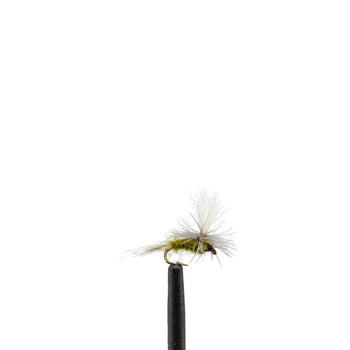
|
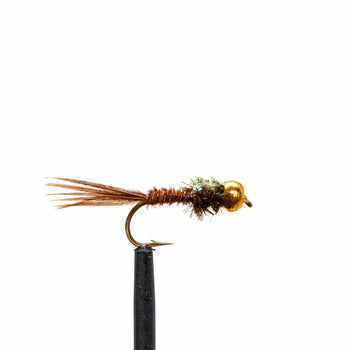
|
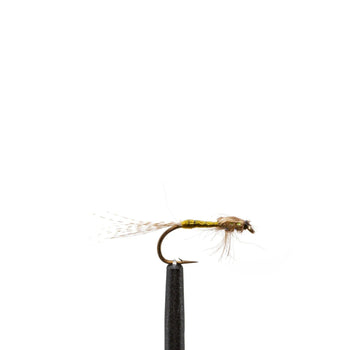
|
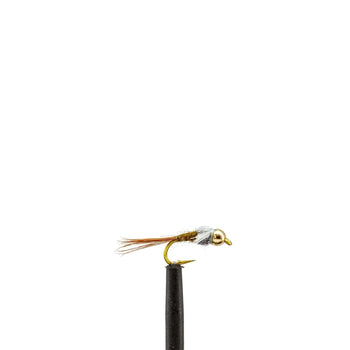
|
| BWO Parachute | Beadhead Flashback Pheasant Tail | WD-40 | Beadhead BWO Emerger |
- BWO Parachute (Sizes 16-22): With its slim body and upright white post, this classic dry fly is easy to see and floats flush in the film. It’s a go-to choice when trout are rising steadily to adult BWOs, and it works in everything from slick tailouts to gentle seams.
- Beadhead Flashback Pheasant Tail (Size 16-20): A reliable nymph that imitates young mayflies. Simple to fish—just drift it under an indicator or in a nymph rig before the hatch—and it will take fish whether you’re new to the sport or an experienced angler fine‑tuning your drift.
- WD-40 (Olive, Gray, or Black, Sizes 18–22): A simple but deadly emerger pattern that fools selective trout. Especially effective on pressured rivers and tailwaters when fish ignore standard dries.
- Beadhead BWO Emerger (Sizes 18-22): Designed to sit just under the surface as mayflies emerge. Fish it on a dropper below a dry or swing it gently at the end of your drift to tempt trout feeding just beneath the rise forms.
📌 Pro Tip: During a BWO hatch, trout may change feeding preferences quickly. Keep a dry, an emerger, and a WD‑40 rigged and rotate until you find what they’re eating. Greasing only the top half of your leader helps emergers ride naturally while your dry serves as both fly and strike indicator.
2. October Caddis
October Caddis (Dicosmoecus) are a fall spectacle, with large adults (#8-14) emerging in October on many western rivers, creating frenzied surface action. These tan/orange sedges hatch from mid-afternoon into evening, often in warmer tailwaters or freestone streams. Trout key on the bulky pupae and fluttering adults. Focus on pupa patterns subsurface during emergence and dries for adults. Below is a top 10 list of battle-tested patterns, based on guide insights and angler reports. Use #10-12 hooks in tan, orange, and grizzly hackle tones.
When to Expect: Mid‑September–late October (peaks vary by river).
- Orange Foam Stimulator (Sizes 8-12): A big, buoyant dry that imitates the adult October Caddis. Fish it dead‑drifted in riffles or add twitches to mimic the natural skating motion across the surface.
- Beadhead Hare’s Ear Flashback (Sizes 12-16): A versatile nymph that matches the caddis pupa stage. Easy for beginners to fish under an indicator, yet effective enough for advanced anglers to tight‑line in deeper runs.
- Caddis Pupa (Sizes 14-18): A must‑have subsurface option for trout keying on ascending pupae. Best fished as a dropper below a Stimulator or on a two‑fly rig near structure.
- Goddard Caddis (Sizes 8–12): A classic deer‑hair pattern that rides high and skates beautifully. Excellent for covering broken water when trout are aggressively chasing adult caddisflies.
📌 Pro Tip: As evening falls, focus on current seams and pocket water. Skating a Stimulator or Goddard Caddis in short, choppy bursts often triggers explosive strikes from big brown trout moving into pre-spawn aggression.
3. Mahogany Dun
Mahogany Duns (Drunella, often called Autumn Duns or Small Western Green Drakes) are a subtle fall mayfly hatch, peaking in September-October on freestone rivers. These #12-18 reddish-brown duns emerge in cooler afternoons, drawing selective sips from trout in riffles and seams. Nymphs are key pre-hatch, with emergers and duns shining during sporadic rises. Tie in mahogany/reddish hues; focus on #14-16 for most waters.
When to Expect: Late September through October
- Parachute Mahogany Dun (Sizes 14-18): A visible dry that rides low and imitates the adult mayfly. Excellent for delicate presentations in slow glides and foam lines.
- Rusty Spinner (Sizes 14–18): Flat mahogany body with ruddy hackle, designed to match egg-laying spinners after the hatch. Dead-drift in slower water during evening falls when trout rise quietly.
- Brown Emerger (Sizes 16-18): A soft-profile fly that sits just under the film. Perfect for trout swirling but not fully breaking the surface.
- Mahogany Spinner (Sizes 14–18): A slim, spent-wing pattern that matches egg-laying adults. Drift it low and still on calm water during spinner falls, often right before dark when trout are sipping gently.
4. Midges
Midges (Chironomidae) are fall's unsung heroes, providing reliable trout chow when bigger hatches taper off. These tiny #18-28 insects emerge in cooler tailwaters, lakes, and spring creeks from September through freezes, often in low light or evenings. Trout feed heavily on pupae ascending and clusters on the surface—expect subtle rises. Focus on beadheads for depth and dries for film action. Use black, olive, or red; #22 is a sweet spot for most.
When to Expect: October through winter
- Zebra Midge (Sizes 18-24): Slim, wire-bodied pupa available in black, red, or olive. Easy to fish under an indicator or in a tandem nymph rig, and one of the most dependable subsurface flies you can carry.
-
Griffith’s Gnat (Sizes 18-24): With its bushy hackle, this fly imitates midge clusters on the surface. Simple to fish on a dead drift, and one of the easiest dries for spotting subtle surface sips.
- Berger's Badger Gnat (Sizes 18-24): A sparse emerger pattern that hovers in the surface film. Perfect when trout are rising quietly but not taking full adults.
- Disco Midge (Red, or Chartreuse,Sizes 18-22): A flashier version of the standard midge, with a bit of sparkle that draws attention in clear water. Great for sunny afternoons when fish get selective.
📌 Pro Tip: Use 5.5X–6X tippet and keep casts short. Close, accurate drifts out-produce long casts, especially when trout are sipping midges in calm water.
Streamers and Terrestrials: Fall Fishing Game-Changers
While it’s essential to match fall hatches, streamers and terrestrials add another powerful dimension to your strategy. As brown trout grow more aggressive before the spawn, they respond eagerly to bigger meals like baitfish and terrestrials. Downsizing patterns in fall often pays off, as smaller streamers resemble juvenile trout or sculpins—substantial food sources that don’t overwhelm fish in cooler water. This balance of size and realism makes streamers and terrestrials a smart option for anglers of all skill levels.
Streamers
Streamers are fall's power play, mimicking baitfish, leeches, and sculpins as trout bulk up for winter in rivers like the Yellowstone or Colorado's big waters. From September through November, cooler temps trigger aggressive chases in deeper runs and undercut banks—strip retrieve with pauses to trigger strikes. Focus on olive, black, and white; #4-8 hooks for big fish. Pair with sinking lines for depth.
When to Expect: September through November is prime for streamer fishing, coinciding with brown trout moving toward their spawn. While large patterns have their place, downsizing often yields more consistent action in the cooler water. Cloudy days and rising flows are particularly effective conditions.
- Wooly Bugger (Regular, Beadhead, or Conehead, Sizes 6–10): The most versatile streamer ever tied. Its marabou tail gives irresistible movement, whether dead-drifted, swung, or stripped. Use beadhead or conehead versions to get down deeper in faster runs.
- Sex Dungeon (Sizes 2–6): A big, articulated pattern built to move water and provoke violent strikes from predatory browns. Available in a wide range of colors—darker tones like black and olive excel in low light or stained water, while brighter two-tone patterns like yellow, white, or red/white trigger aggressive takes in clear conditions. Best on sink-tip lines with slower retrieves and pauses.
- Muddler Minnow (Regular or Conehead, Sizes 6–10): A classic sculpin imitation. The conehead version sinks quickly, while the regular excels for swinging through shallower runs.
- Zonker (Sizes 6-10): With its flowing rabbit strip, the Zonker provides lifelike movement. Offered in natural tones (olive, brown, white) for realistic sculpin or baitfish imitations, and brighter colors (chartreuse, black/white) for attractor fishing when trout are aggressive. Effective when fished near structure, undercut banks, or swung across deeper runs.
📌 Pro Tip: Pair streamers with a sink-tip line and a short 4–6 foot leader to keep your fly in the strike zone longer. Experiment with colors: dark patterns at dawn, dusk, or in murky water; bright or two-tone options in clear or sunny conditions.
Terrestrials
Terrestrials—hoppers, ants, beetles, and crickets—bridge late summer into fall, tumbling into rivers via wind or bank scrambles on freestone streams and meadows. From September through early frosts, these chunky #8-16 bugs provoke explosive strikes from trout gorging pre-winter. They're ideal for windy days or when hatches stall, fished with short leaders and downstream plops. Use tan, black, and foam for durability.
When to Expect: Early to mid fall on warm, sunny days before the first hard frosts. Afternoons are typically best when terrestrials are most active.
-
Black Ant (Sizes 14-18): A simple, high-confidence pattern that imitates ants blown onto the water. Trout often sip these quietly on calm days, making them an important option in your fall fly box.
-
Dave’s Hopper (Sizes 8–12): A classic hopper imitation with a realistic deer-hair body and wing. Perfect for drifting along grassy banks on warm afternoons when hoppers are most active.
-
Chubby Chernobyl (Sizes 8–12): A modern foam-bodied attractor that floats high, holds up a dropper, and draws aggressive strikes. Excellent for hopper-dropper rigs or as a prospecting fly.
-
Parachute Hopper (Sizes 10–14): A more realistic hopper profile with a parachute post for visibility. Rides low in the film and excels in slower water where trout inspect flies more carefully.
📌 Pro Tip: Terrestrials pair perfectly with droppers. Run 18–24 inches of 5X or 6X tippet to a small tungsten nymph (16–20) beneath your hopper to cover both surface and subsurface feeding lanes.
Key Fall Fly Fishing Tips
Success in fall fly fishing often comes down to adapting your approach as conditions change. Cooler nights, shorter days, and shifting insect activity all affect how trout feed. Keep these tips in mind to make the most of your time on the water:
-
Be Prepared for Cooler Weather: Fall fishing means colder mornings and evenings. Dress in layers, wear proper insulation, and bring along hand warmers or a thermos of coffee for those brisk dawn hours.
-
Slow Down Your Presentation: As water temperatures drop, trout metabolism slows. Lethargic fish won’t chase aggressively, so emphasize slower drifts, longer pauses, and deliberate presentations. A carefully placed fly often outproduces a dozen rushed casts.
-
Fish the Right Time of Day: Unlike summer, when dawn and dusk are prime, fall hatches often peak during midday warmth. Target late morning through afternoon windows for Blue-Wing Olives, Mahoganies, or midges when insect activity is highest.
-
Focus on Deeper Water: Water: Lower flows concentrate trout in deeper runs, pools, and seams. Use weighted nymphs, streamers, or emergers to reach them. Pay extra attention to the heads and tails of pools where fish stage to intercept drifting food.
- Adjust Quickly: Fall conditions change fast—clouds roll in, temperatures drop, and hatches shift suddenly. Keep a mix of dries, emergers, and nymphs rigged so you can pivot without retying your entire setup.
📌 Pro Tip: A 10–12 foot leader with 5X–6X tippet gives you the reach and finesse needed for spooky trout in clear fall water. Add tippet rings or micro swivels to swap rigs quickly without shortening your leader.
Taking it to the Water
Fall is a magical time to be on the water. The changing landscape, crisp air, and aggressive trout all combine to make for unforgettable days on the river. By understanding the unique hatches of the season and using the right flies, you’ll increase your chances of landing quality fish during this exciting time. Whether you're fishing a delicate BWO hatch or stripping streamers for trophy browns, fall fly fishing offers something for every angler.
So grab your gear, tie on your best fall patterns, and get ready to enjoy one of the finest seasons in fly fishing!
SHOP THE FALL FLY COLLECTION
RELATED ARTICLES:
-
Mastering Fall Streamer Fly Fishing: Tactics, Patterns, and Strategies for Trophy Trout
-
How to Fish Low Water in Early Fall – Best Rod & Line Setups
- Fly of the Month: Targeting Fish with Egg Patterns During the Fall Spawning Season
- 10 Trout Fishing Tips for Fall
- Fall Fly Fishing for Brook Trout: Essential Tips & Techniques


